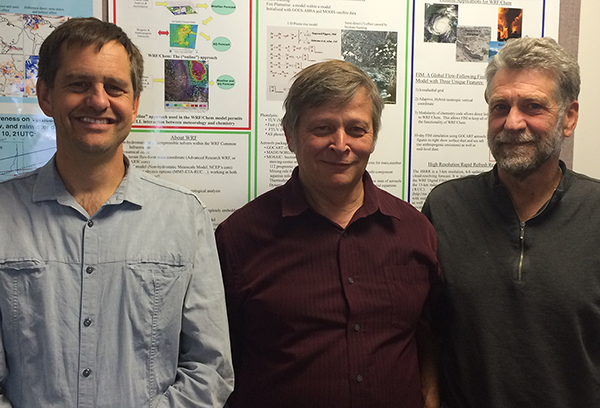A .gov website belongs to an official government organization in the United States.
A lock () or https:// means you've safely connected to the .gov website. Share sensitive information only on official, secure websites.
4 October 2021
adapted from the story by NOAA GSL Communications

A 2005 paper published in the Elsevier journal Atmospheric Environment was identified as one of the top ten papers that has influenced the field of tropospheric chemistry. The paper was led by GSL's Georg Grell, and co-authored by CSL's Stuart McKeen and Greg Frost and others. The article has 1332 citations on Web of Science and 1436 on Scopus (dated 27 March 2020).
The statement comes from Papers that shaped tropospheric chemistry, an opinion letter published in the European Geophysical Union journal Atmospheric Chemistry and Physics.
The Grell et al. publication discusses how the simulation and prediction of meteorological factors such as wind speed and direction, turbulence, radiation, clouds, and precipitation, influence the prediction of air quality with an online coupled modeling system. Historically, chemical transport modeling systems treated air quality and meteorology independently, known as "offline."
In the paper, the researchers describe how they integrated chemical processes into the existing Weather Research and Forecasting (WRF) model making it fully coupled and "online." The "WRF-Chem" air quality and meteorological components are consistent with each other and use the same transport scheme, the same grid, and the same physics schemes for subgrid-scale transport.
The 2005 paper also compared the WRF-Chem Model output with previous chemistry models and found it to be just as accurate in predicting photochemistry and emissions as previous models while providing better forecasts of ozone and ozone precursors. Since the paper's publication in 2005, the WRF-Chem model has become the standard for research in air quality as well as research on impacts of aerosol and chemistry on numerical weather prediction. WRF-Chem is now a community model – support provided by GSD – and has more than 2000 users worldwide.
This paper was also awarded the 2016 Haagen Smit prize. The international Haagen-Smit Prize recognizes outstanding papers published in the Elsevier journal Atmospheric Environment. The fact that their paper was published in 2005 and was selected for this prestigious prize in 2016 shows its long-term influence in the field.
Grell, G.A., S.E. Peckham; R. Schmitz, S.A. McKeen; G. Frost, W.C. Skamarock, and B. Eder, Fully coupled 'online' chemistry within the WRF model, Atmospheric Environment, doi:10.1016/j.atmosenv.2005.04.027, 2005.
A fully coupled "online" Weather Research and Forecasting/Chemistry (WRF/Chem) model has been developed. The air quality component of the model is fully consistent with the meteorological component; both components use the same transport scheme (mass and scalar preserving), the same grid (horizontal and vertical components), and the same physics schemes for subgrid-scale transport. The components also use the same timestep, hence no temporal interpolation is needed. The chemistry package consists of dry deposition ("flux-resistance" method), biogenic emission as in [Simpson et al., 1995. Journal of Geophysical Research 100D, 22875–22890; Guenther et al., 1994. Atmospheric Environment 28, 1197–1210], the chemical mechanism from RADM2, a complex photolysis scheme (Madronich scheme coupled with hydrometeors), and a state of the art aerosol module (MADE/SORGAM aerosol parameterization).
The WRF/Chem model is statistically evaluated and compared to MM5/Chem and to detailed photochemical data collected during the summer 2002 NEAQS field study. It is shown that the WRF/Chem model is statistically better skilled in forecasting O3 than MM5/Chem, with no appreciable differences between models in terms of bias with the observations. Furthermore, the WRF/Chem model consistently exhibits better skill at forecasting the O3 precursors CO and NOy at all of the surface sites. However, the WRF/Chem model biases of these precursors and of other gas-phase species are persistently higher than for MM5/Chem, and are most often biased high compared to observations. Finally, we show that the impact of other basic model assumptions on these same statistics can be much larger than the differences caused by model differences. An example showing the sensitivity of various statistical measures with respect to the treatment of biogenic volatile organic compounds emissions illustrates this impact.